The 1980s were a boom time for large, colourful murals across London, and for today’s post I am revisiting two of these, to find the sad fate of two Greenwich murals.
Walk east along Creek Road which leaves central Greenwich near the Cutty Sark DLR station, turn right down Horseferry Place, and in 1986 you would have seen the El Salvador mural in all its pristine colours, as photographed by my father:

I recently visited the site, and found the mural in a very sad condition. Very faded and with Sky satellite dishes and a number of lights installed across the mural:
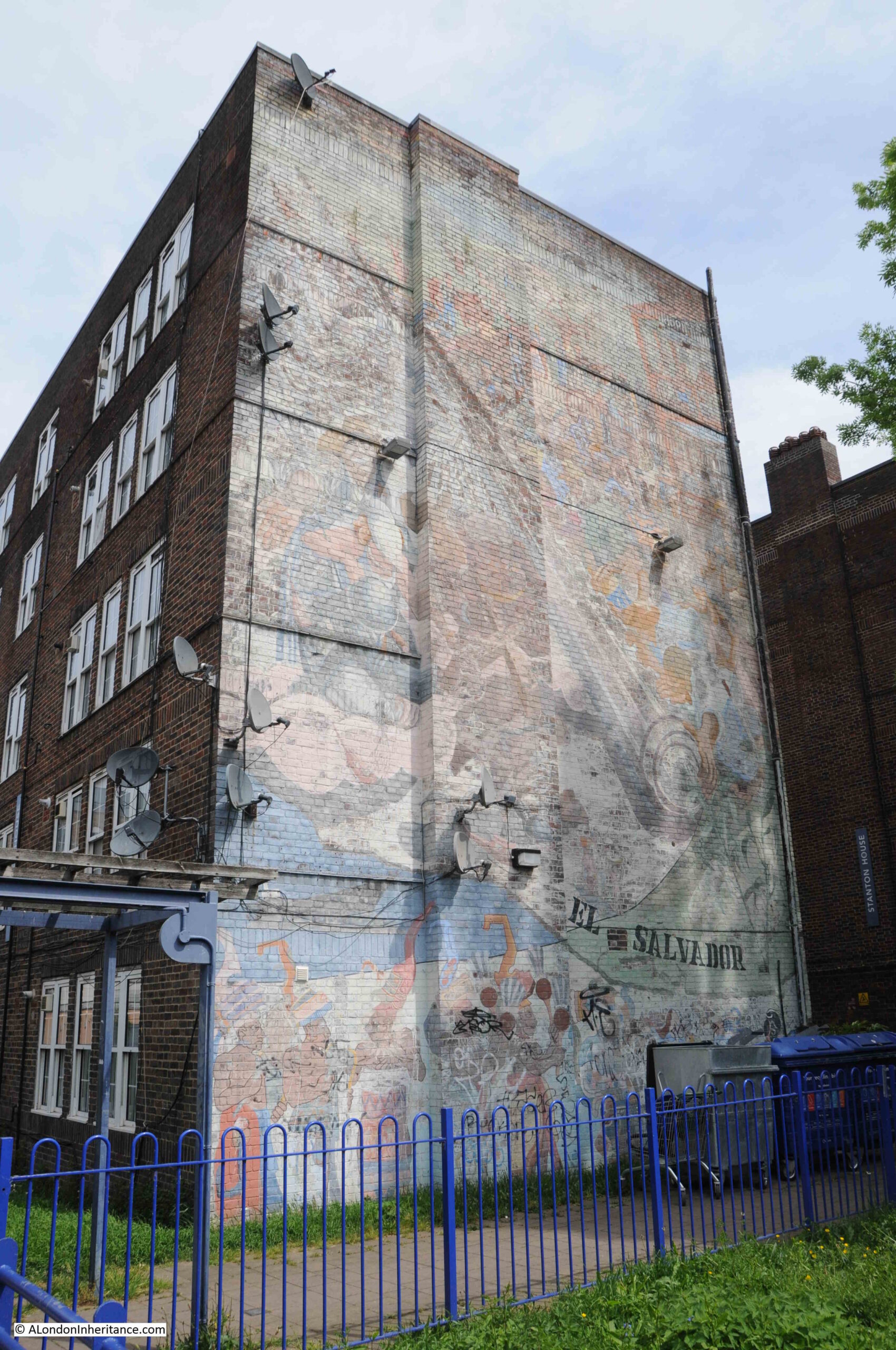
The El Salvador mural, or as it was originally titled “Changing the Picture”, was created for the El Salvador Solidarity Campaign in 1985, the year before my father’s photo.
The El Salvador Solidarity Campaign was based in Islington Park Street and was formed to express support for the people of El Salvador.
El Salvador is a country in central America and during the 1980s was suffering from a violent Civil War that would not really end until 1993, and resulted in the deaths of tens of thousands of the country’s population.
The civil war was mainly a conflict between the left wing Farabundo Martí National Liberation Front (FMLN), supported by the neighbouring countries of Nicaragua and Cuba, and the Government of the country, supported by the United States.
The people of the country paid a terrible price during the civil war. There were atrocities committed by both sides, however the military of El Salvador along with “Death Squads” who operated outside the official knowledge of the military or government, would commit the majority.
As well as the internal issues within the country, it was also a proxy conflict between the US and the Soviet Union, with US concern about the potential growth of Communist supporting governments in central America, which could have been the outcome if the US supported government had fallen to the FMLN.
There were a number of international groups supporting the people of El Salvador and the FMLN, including in the US and the El Salvador Solidarity Campaign in London.
The aim of the mural is to show the ordinary people of El Salvador (on the right) taking back control of their country, lives and future by “rolling up the picture”.
The people on the right are depicted in bright colours, with more muted, grey colours for the military, and the military / industrial support that contributed large quantities of arms to the country.
I believe the following extract from the mural shows Ronald Regan and Margaret Thatcher to the left with a figure representing El Salvador’s military on the right, controlling a puppet soldier:
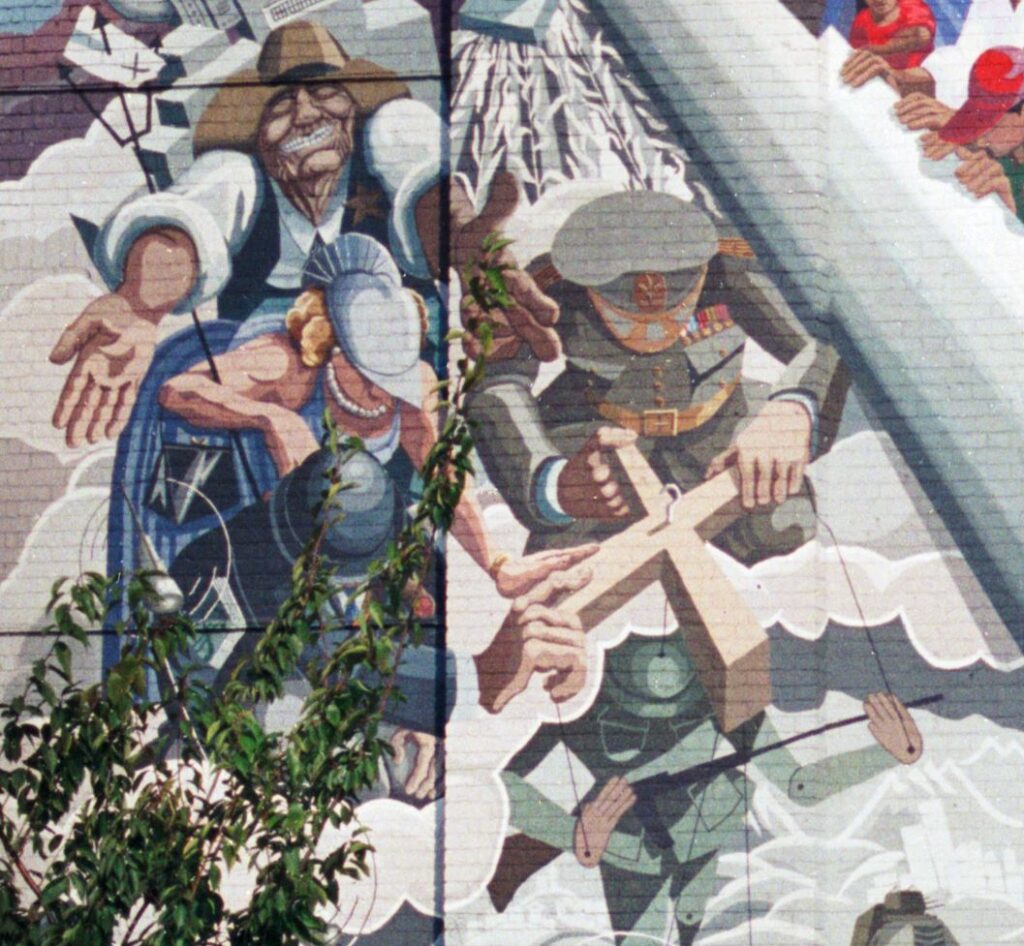
Whilst the mural was commissioned by the El Salvador Solidarity Campaign, it was funded by the Greater London Council (GLC), and support of initiatives such as the mural was one of the many reasons why the Conservative government of the 1980s would abolish the GLC at the end of March 1986.
The mural was created by the artist Jane Gifford, along with Nick Cuttermole, Sergio Navarro and Rosie Skaife D’Ingerthorpe.
I could not get a photo of the mural at the same angle as my father’s. He was standing in the adjacent school playground, and today this is completely fenced.
The following view shows a wider view of the El Salvador mural, on the side of Macey House which is part of the Meridian Estate:
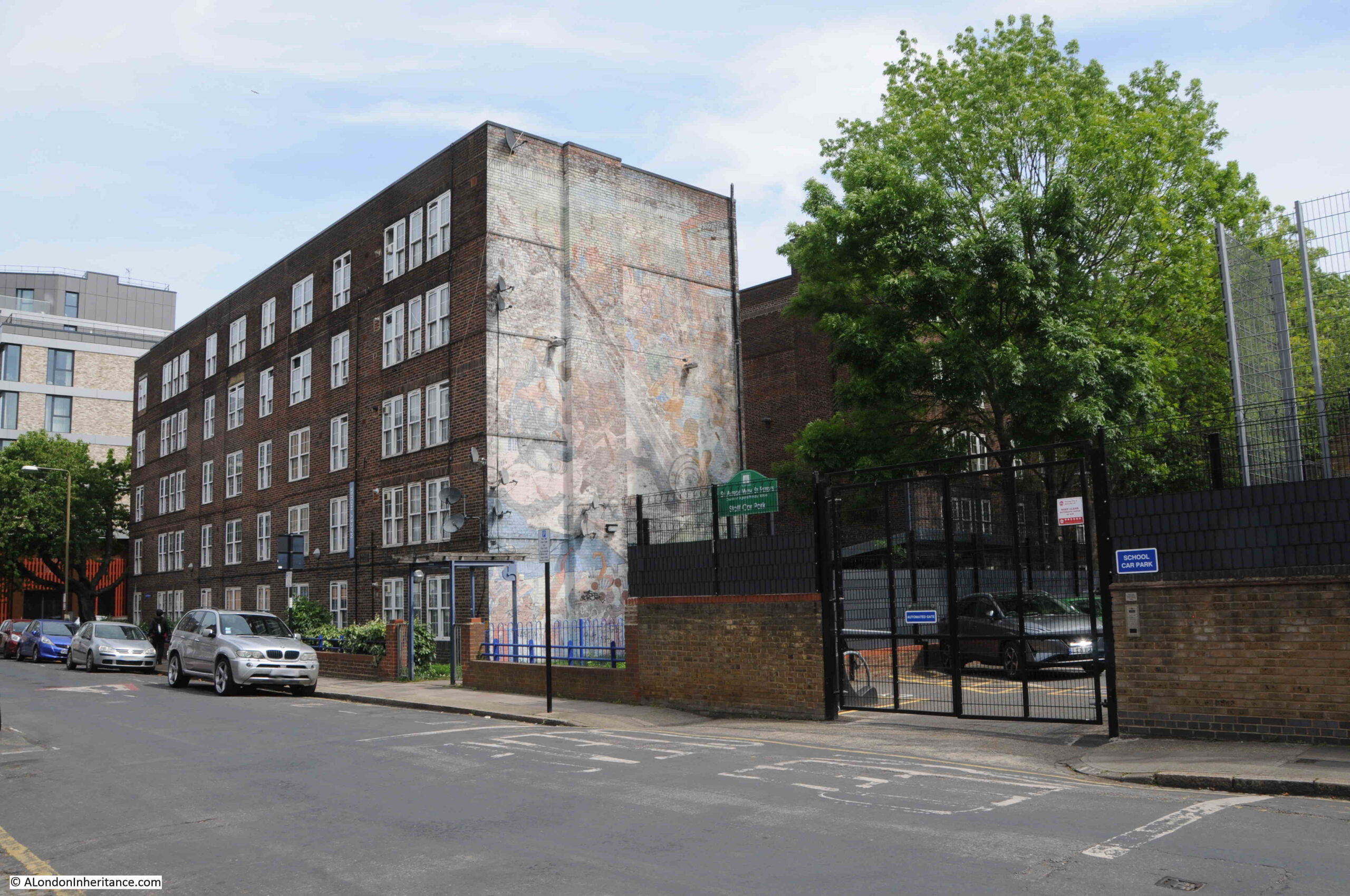
Macey House is on Horseferry Place, a road that leads down towards the Thames. The name of the road records a ferry that once ran from near the southern end of the road across to the Isle of Dogs.
The following map shows the location of the two murals that feature in today’s post. The El Salvador mural is the red circle, number 1 (© OpenStreetMap contributors):
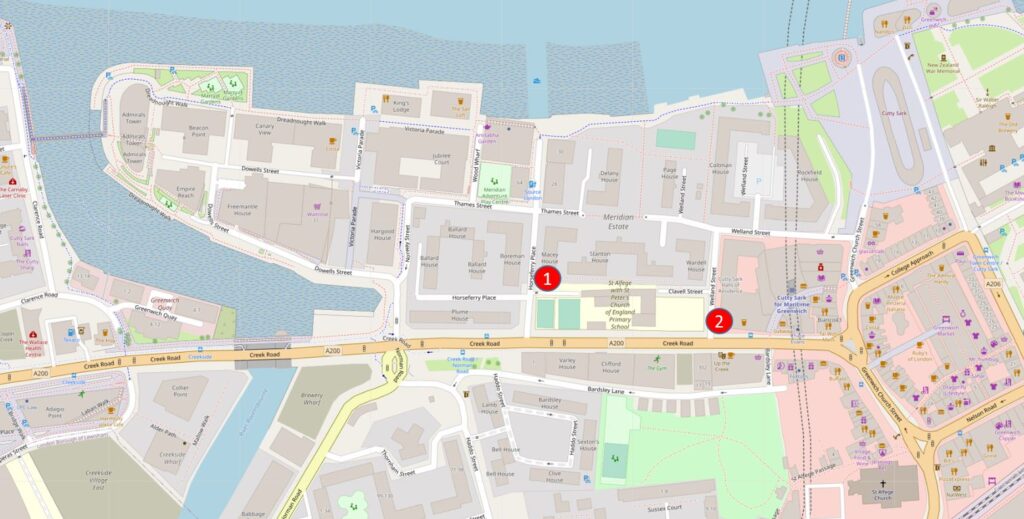
A short distance from the El Salvador mural, heading back towards Greenwich, along Creek Road was the “Wind of Peace” mural, at point number 2 on the above map:
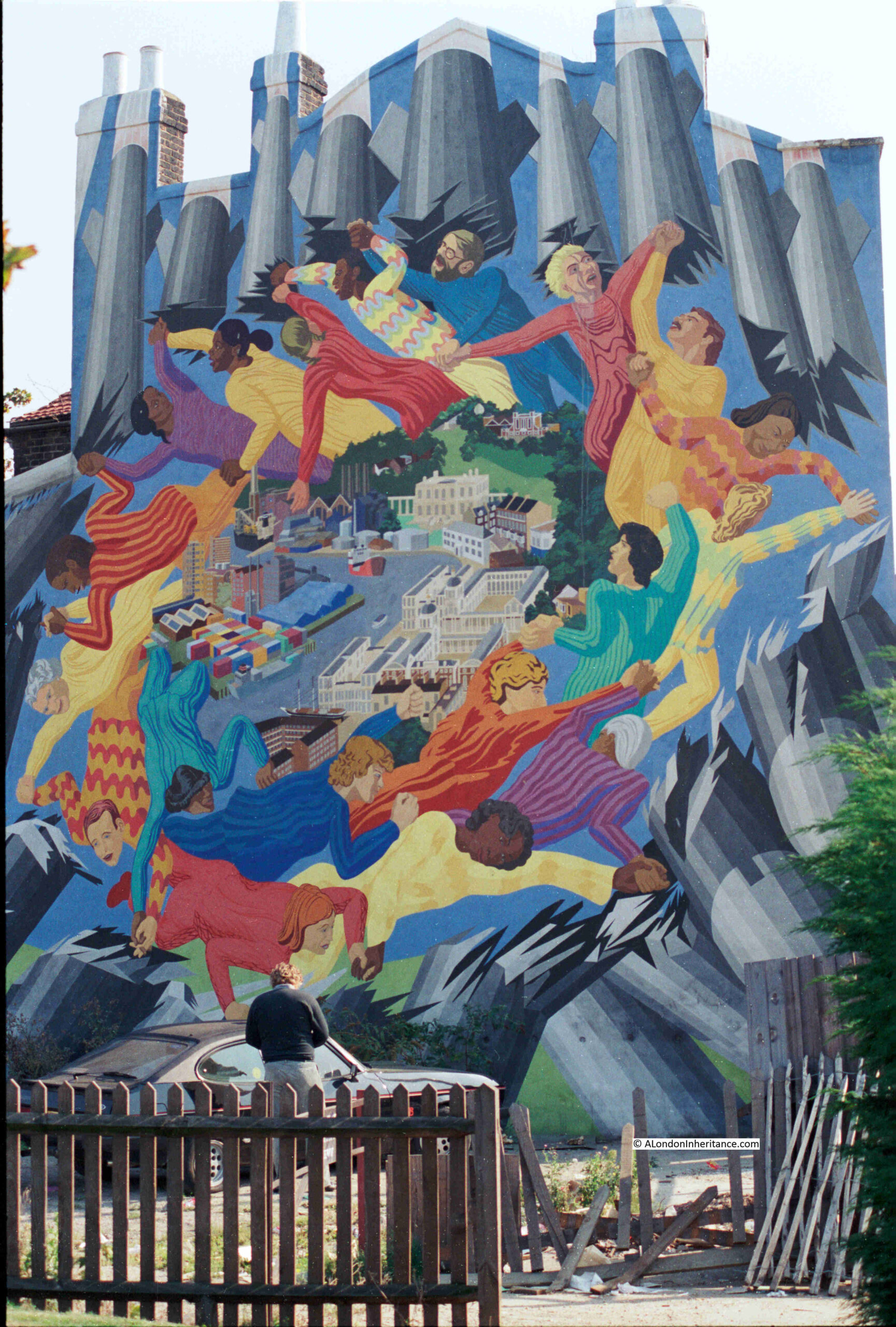
Although the El Salvador mural is very badly faded, the Wind of Peace has suffered an even worse fate – the mural, along with the building on which it was painted, have completely disappeared.
In the photo below, there is a large new building on the left, with a terrace of smaller buildings further back, heading along Creek Road back into the centre of Greenwich.

The mural was on a building which stood where the large building with the clock is now located. The mural was on the side wall and would have been facing the camera.
The development on the left leading back into Greenwich was following the completion of the Cutty Sark DLR station, which is accessed through a pathway to the left of the van, at the junction of the large and smaller buildings.
The Wind of Peace mural was commissioned by the London Muralists for Peace initiative, as part of the 1983, Greater London Council’s Peace Year.
The mural was painted by artists Stephen Lobb and Carol Kenna, and replaced an earlier mural showing the river and the land alongside the river in Greenwich.
The mural has Greenwich in the centre of the mural, with the residents flying around the view of Greenwich, resisting and destroying missiles which symbolised the threat of nuclear war.
The GLC 1983 Peace Year comprised not just murals, but a whole series of events throughout London. A typical newspaper campaign advert covered:
“Peace is the most important issue facing us all. London could not survive a nuclear holocaust, irrespective of whether it is triggered by miscalculation in Washington or Moscow.
The GLC has declared 1983 Peace Year to give Londoners the opportunity of making a personal commitment to this highest of human ideals.
There can be no better way for people to express their desire for peace than through the Arts. That is why a major part of GLC Peace Year activities will involve supporting drama, film and the visual arts.
Come along and enjoy GLC Peace Year events and activities listed below. Support the cause of peace in London and give a peaceful lead to the world.
- April 3 Easter Parade featuring specially commissioned Peace Float, Battersea Park at 3pm
- May 1 May Day Festival, Victoria Park – at noon
- May 5 Songwriters Competition for Peace – launch
- June 4 Free Music Concert for Peace, crystal Palace Bowl at noon
- July 16 Peace Concert of Classical Music, Kenwood Lakeside at 8pm
- August 6 Hiroshima Day Peace Festival, Victoria Park at noon
- August 7 Peace Concert of Classical Music, crystal Palace Bowl at 8pm”
There were many more events in addition to those listed above, including a Festival for Peace at Brockwell Park on May the 7th, which included the Damned, Madness and Hazel O’Conner.
As well as the Arts, Peace Year included other projects such as the construction of a number of “peace gardens” across London, such as the Noel-Baker Peace Garden in Islington.
The civil war in El Salvador ended almost thirty years ago, and the mural is gradually fading as are memories of the war (although the country still does suffer from some instability, including the recent bizarre decision to adopt Bitcoin as legal tender within the country).
The Wind of Peace mural disappeared as did the apparent threat of nuclear war, however with current unpredictable world events – perhaps it may be time for another mural.

Thank you for this reminder of the sad history of this country. You failed to mention the assassination of Archbishop Oscar Romero by the regime, 24 March 1980, while saying mass in his cathedral in the capital San Salvador. He has now been declared a Saint by the Catholic Church.
Archbishop Oscar Romero is one of the 10 20th Century Martyrs immortalised by a statue above the West entrance to Westminster Abbey. I didn’t know he was now a saint.
Thanks.
I wonder what happened to all the artists
A great piece. I remember so many of these murals all around London as a kid and unfortunately too many have either faded away or been replaced with blocks of bland glass, metal & concrete. The 80’s were not great times but there was a certain vibrance that has also disappeared. We had a lot to thank the GLC for in those days no wonder Maggie scrapped it.
Such talent should not be forgotten.
I love murals.
The 80s wasn’t all Gordon Gecko and City boys . A few miles up the road was the People’s Republic of Islington, very left wing and alternative and the nurturing ground for a lot of interesting projects. Doesn’t surprise me that the El Salvador Solidarity campaign in the UK had it’s headquarters there.
Islington was a very alive place to live in those days.
Interesting as always. From.my personal perspecive the article recalls the good reasons for getting rid of the GLC. One of which was its continual spending of public money on
left wing propoganda art like these murals. I recognise of course that other views are possible.
But don’t you think it’s laudable that the combined powers of Madness, the Damned and the residents of Greenwich under the orchestration of the GLC, could neutralise nuclear weapons and enforce World Peace ?
There’s a wonderful mural on the end wall of a school in Somer’sTown, depicting many of its residents both real and fictional from the late 18th century on. You might want to devote a future column to that neighbourhood if you haven’t already done so. Sorry I can’t give more details, not having access at the moment to my computer.
Ann Pearson
Thanks so much for this remarkable piece of research!
1983 was a time of such turmoil, both here and in the US, with the Reagan and Thatcher governments hugely increasing the nuclear arms race and Reagan directly funding governments in El Salvador and Nicaragua which had hit squads killing their own people (including the great campaigner for peace, Archbishop Romero, for one, who was murdered in front of his congregation as he was saying mass)…
But the people’s of Central America, the US and Europe stood up very visibly against what their governments were doing, the peace movement was very widespread with the largest demonstrations ever across the globe, including those festivals of peace and murals against dictatorship and the arms race that the people’s GLC facilitated!
I remember being in New York City then and the many rallies for the people of El Salvador, who were living through a terribly tragic time that lasted many years. In New York a million people came to take part in an anti-nuclear arms demonstration that spring, filling the entire city which was unexpectedly completely shut down by the masses of people who filled Central Park and stretched all the way down to Greenwich Village in the name of Peace.
And, just a bit earlier in 1981, I remember how Rock Against Racism spread across the UK at a time that the National Front was also rising. The atmosphere at the anti-racism concert in the park in Stockwell, in South London, which I attended with some openly gay friends was amazing, bringing people together in between the two large and frightening riots in Brixton that marked that summer.
Thank you for bringing this important time alive again through your column, research and photos!
Is the huge colourful mural against the arms race in Brixton still there? A 5-story tall warning image of a skeleton seeking to rain missiles down while a dove of peace flies in the sky offering a way forward…
I see someone above has asked what happened to the artists? and I wondered why this piece has come out again today. I have been right through it but can’t see any mention of the recent death of Steve Lobb -who did so many murals in Greenwich, and elsewhere and who you mention above as one of the artists on ‘Wind of Peace’. I hope anyway that this article was some sort of contribution towards a memorial of his work.
Carol is very much still around!
It is worth adding that Greenwich Borough became a Nuclear Free zone in 1982 – recorded in Hansard.
Greenwich Mural Workshop (Carol Kenna and Stephen Lobb) joined forces with fellow mural artists Ray Walker, Brian Barnes, Dale McCrea & Pauline Harding, Paul Butler to form the London Muralists for Peace. Tony Banks, then deputy leader of the GLC, designated 1983 as ‘Peace Year’. The group received a grant of £40k which was shared between the arts groups resulting in 6 murals advocating a non nuclear world policy between 1983 /84. Tony Banks personally ‘opened’ the “Wind of Peace” and Brian Barnes’s ‘Riders of the Apocalypse ‘ in New Cross on the same day.